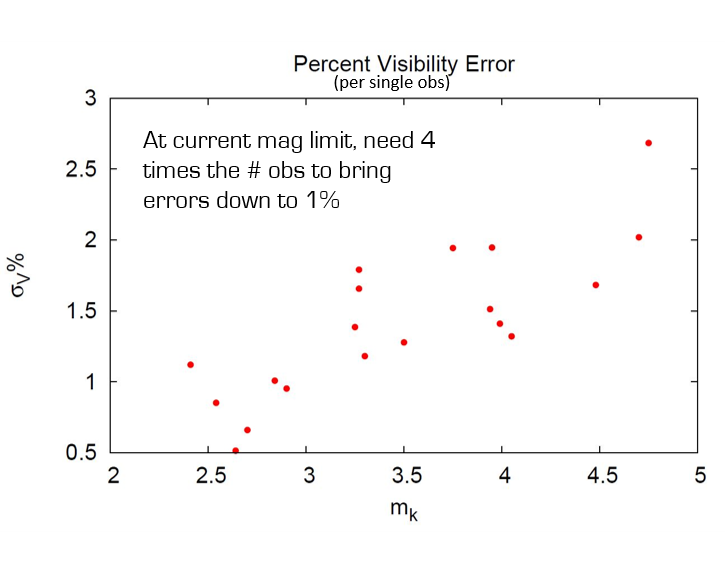
Exozodiacal Dust Disks
- Not to be confused with debris disks
- Require interferometry to detect
- High levels (100-1000 zodi) even in >100 Myr systems
- Confound the detection of exoEarths
- Probe the structure of inner system
1 AU terrestrial planet with gap
0.5 – 1.5 AU warm dust disk 500K
0.1 – 0.5 AU hot dust disk > 1000K
Center A0 star @ 10 pcc
< 100K
100 AU
100-1400K
< 10 AU
HZ
Our disk is the most luminous object in SS after the Sun.
Earth would be a clump in the zodi at visible and IR [Kelsall+1998]
10-20 zodi would compromise exoEarth detection [Beichman+2006,Roberge+2012]
Interferometric, astrometric, direct, photometric, ...
exoEarth detection becomes challenging if exozodi level is ~20 zodis and clumpy [Defrère+SPIE 2012]
exoEarth detection is divided by factor of 2 for exozodi level increase of 10 [Stark+2014]
\(\geq\)10% of Gyr old MS stars may have enough exozodi dust to complicate exoEarth imaging [Kennedy & Wyatt 2013]
Resonant structures could indicate planets indirectly [Wyatt+1999]
Excess incoherent flux from dust creates challenges for design of coronographs and starshades


Nuñez, Scott, Mennesson 2017

NIR detections
Ertel+2014 merged FLUOR+PIONIER samples (n~125) reaching 0.25% precision


VLTI - PIONIER
-
Rate decreases across spectral type
-
Matches cold disk trend. Common origin?
-
-
No correlation b/t hot dust and cold dust.*
-
Different origin for hot and cold discs?
-
-
Slight increase in exozodi detection with stellar age
-
No correlation b/t exoplanets and exozodi.
HD 7788 shows variability
excess disappeared for a year




iot Psc
ups And
kap CrB
gam Ser
Absil+2013 detections
increased excess
new excess

Scott+2015 revisits
1% CSE threshold
Sample of monitoring targets
You can't trust that a non-excess star will always remain one.
All 5 or more brackets, 3 cross-checked calibrators, targets and cals checked for binarity by interferometry AND speckle.
Scott dissertation 2015
Science/mission Goals
-
Explore the apparent variability of known exozodis
- long-term monitoring
- clues to source and formation of the dust
-
Expand strong exozodi sample
- leveraging LBTI and prior surveys
- from ~100 \(\rightarrow\) ~1000 objects
- Use spectral dispersion to resolve the thermal/scattered dilemma
- Risk mitigation for coronagraphy/starshade missions
-
Target selection and characterization for mid/large missions (TESS, LUVOIR, HabEx, etc)
- exozodis likely to be dominant noise source
- Precision diameters and fundamental astrophysics
- Maintain a high angular resolution interferometric capability, unique to the Northern Hemisphere
Science gaps on Exoplanet program office list
-
Science gap Number 4
- Planetary System Architecture
-
Science gap Number 6
- Yield estimation for exoplanet direct imaging missions
-
Science gap number 7
- Improve target lists and compilations of stellar parameters for exoplanet missions in operation or under study
-
Science gap number 10
- Precursor surveys of direct image targets
-
Science gap Number 11
- Understanding the abundance and distribution of exozodiacal dust

JouFLU upgrade paths
JouFLU prior limit

JouFLU potential
JouFLU present
Getting to 5th mag could more than double the number of targets observable
CHARA AO is now coming online \(\rightarrow\) greatly improved obs efficiency
Goal is 1% excess detection at 5σ to mK < 5.


2019B - IO produced
2020A - install at CHARA
2020B - science observations begin
-
ZBLAN IO chip
- losses ~0.4 db/cm
- get H band IO chip as "bonus"
- ~$50k
-
v-groove and coupling optics (Ozoptics)
- ~$20k
-
optomechanics
- ~$75k
- 2 or 4 beam H+K simultaneous
Saphira Selex detector
- will enable drastically better spectrally dispersed results
- $350k
Bertand/Nic
JPL internal funds